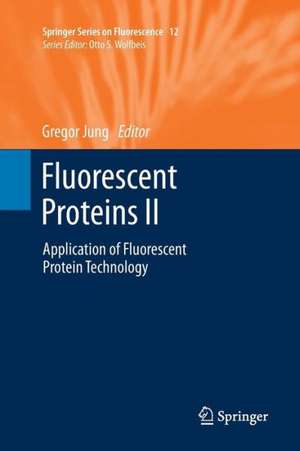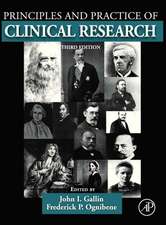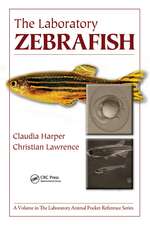Fluorescent Proteins II: Application of Fluorescent Protein Technology: Springer Series on Fluorescence, cartea 12
Editat de Gregor Jungen Limba Engleză Paperback – 22 feb 2014
Fluorescent Proteins II highlights the physicochemical and biophysical aspects of fluorescent protein technology beyond imaging. It is tailored to meet the needs of physicists, chemists and biologists who are interested in the fundamental properties of fluorescent proteins, while also focussing on specific applications. The implementations described are cutting-edge studies and exemplify how the physical and chemical properties of fluorescent proteins can stimulate novel findings in life sciences.
| Toate formatele și edițiile | Preț | Express |
|---|---|---|
| Paperback (1) | 1216.78 lei 6-8 săpt. | |
| Springer Berlin, Heidelberg – 22 feb 2014 | 1216.78 lei 6-8 săpt. | |
| Hardback (1) | 1220.45 lei 6-8 săpt. | |
| Springer Berlin, Heidelberg – 5 ian 2012 | 1220.45 lei 6-8 săpt. |
Din seria Springer Series on Fluorescence
-
 Preț: 401.03 lei
Preț: 401.03 lei - 18%
 Preț: 1818.96 lei
Preț: 1818.96 lei - 18%
 Preț: 1216.16 lei
Preț: 1216.16 lei - 18%
 Preț: 1829.68 lei
Preț: 1829.68 lei - 18%
 Preț: 1225.31 lei
Preț: 1225.31 lei - 18%
 Preț: 2479.52 lei
Preț: 2479.52 lei - 18%
 Preț: 1223.74 lei
Preț: 1223.74 lei - 18%
 Preț: 1225.79 lei
Preț: 1225.79 lei - 18%
 Preț: 1223.25 lei
Preț: 1223.25 lei - 18%
 Preț: 1216.65 lei
Preț: 1216.65 lei -
 Preț: 395.25 lei
Preț: 395.25 lei - 24%
 Preț: 1711.07 lei
Preț: 1711.07 lei - 18%
 Preț: 950.52 lei
Preț: 950.52 lei - 18%
 Preț: 959.82 lei
Preț: 959.82 lei - 18%
 Preț: 964.71 lei
Preț: 964.71 lei - 18%
 Preț: 1240.93 lei
Preț: 1240.93 lei - 18%
 Preț: 1821.03 lei
Preț: 1821.03 lei - 18%
 Preț: 1821.81 lei
Preț: 1821.81 lei - 18%
 Preț: 1824.19 lei
Preț: 1824.19 lei
Preț: 1216.78 lei
Preț vechi: 1483.88 lei
-18% Nou
Puncte Express: 1825
Preț estimativ în valută:
232.85€ • 243.41$ • 196.77£
232.85€ • 243.41$ • 196.77£
Carte tipărită la comandă
Livrare economică 06-20 martie
Preluare comenzi: 021 569.72.76
Specificații
ISBN-13: 9783642446825
ISBN-10: 3642446825
Pagini: 296
Ilustrații: XII, 284 p.
Dimensiuni: 155 x 235 x 16 mm
Greutate: 0.42 kg
Ediția:2012
Editura: Springer Berlin, Heidelberg
Colecția Springer
Seria Springer Series on Fluorescence
Locul publicării:Berlin, Heidelberg, Germany
ISBN-10: 3642446825
Pagini: 296
Ilustrații: XII, 284 p.
Dimensiuni: 155 x 235 x 16 mm
Greutate: 0.42 kg
Ediția:2012
Editura: Springer Berlin, Heidelberg
Colecția Springer
Seria Springer Series on Fluorescence
Locul publicării:Berlin, Heidelberg, Germany
Public țintă
ResearchCuprins
Fluorescent Proteins: Nature’s Colorful Gifts for Live Cell Imaging.- Green Fluorescent Protein Photodynamics as a Tool for Fluorescence Correlative Studies and Applications.- The Proton Sensitivity of Fluorescent Proteins: Towards Intracellular pH Indicators.- Green Fluorescent Protein-Based Chloride Ion Sensors for In Vivo Imaging.- Fluorescent Genetically Encoded Calcium Indicators and Their In Vivo Application.- Action Potentials in Heart Cells.- Probing Structure and Dynamics of the Cell Membrane with Single Fluorescent Proteins.- Fluorescence Correlation and Cross-Correlation Spectroscopy Using Fluorescent Proteins for Measurements of Biomolecular Processes in Living Organisms.- Investigating the Lifecycle of HIV with Fluorescent Proteins.
Recenzii
From the reviews:
“Focuses mainly on quantitative and bioanalytical applications of fluorescent proteins. … Given the rapidly advancing field of fluorescent proteins, this … will be highly valuable both for researchers in and newcomers to this field, although they will mainly be useful as a reference guide for research workers.” (Sapna K. Deo, Analytical and Bioanalytical Chemistry, Vol. 404, 2012)
“Focuses mainly on quantitative and bioanalytical applications of fluorescent proteins. … Given the rapidly advancing field of fluorescent proteins, this … will be highly valuable both for researchers in and newcomers to this field, although they will mainly be useful as a reference guide for research workers.” (Sapna K. Deo, Analytical and Bioanalytical Chemistry, Vol. 404, 2012)
Textul de pe ultima copertă
Fluorescent proteins are intimately connected to research in the life sciences. Tagging of gene products with fluorescent proteins has revolutionized all areas of biosciences, ranging from fundamental biochemistry to clinical oncology, to environmental research. The discovery of the Green Fluorescent Protein, its first, seminal application and the ingenious development of a broad palette of fluorescence proteins of other colours, was consequently recognised with the Nobel Prize for Chemistry in 2008.
Fluorescent Proteins II highlights the physicochemical and biophysical aspects of fluorescent protein technology beyond imaging. It is tailored to meet the needs of physicists, chemists and biologists who are interested in the fundamental properties of fluorescent proteins, while also focussing on specific applications. The implementations described are cutting-edge studies and exemplify how the physical and chemical properties of fluorescent proteins can stimulate novel findings in life sciences.
Fluorescent Proteins II highlights the physicochemical and biophysical aspects of fluorescent protein technology beyond imaging. It is tailored to meet the needs of physicists, chemists and biologists who are interested in the fundamental properties of fluorescent proteins, while also focussing on specific applications. The implementations described are cutting-edge studies and exemplify how the physical and chemical properties of fluorescent proteins can stimulate novel findings in life sciences.
Caracteristici
A comprehensive review Written by experts Richly illustrated Includes supplementary material: sn.pub/extras











